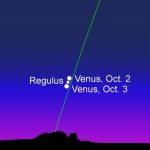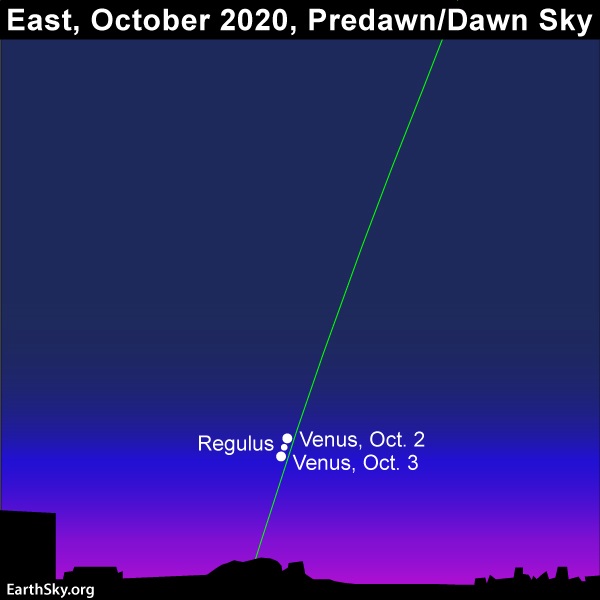

On the mornings of October 1 and 2, 2020, Venus (brighter) and the bright star Regulus will appear near one another in the east before sunup. Here’s the view from North America, where Venus will appear about half a degree above Regulus on October 2, and about half a degree below Regulus on October 3. A degree is about the width of your little finger held at arm’s length. Their conjunction will come on October 3, at 0 hours UTC, at which time Venus will pass a scant 0.1 degree south of Regulus. That’s very close! As seen from western Asia, Venus will come achingly close to brushing against Regulus.
Depending on where you live worldwide, the planet Venus and bright star Regulus – Heart of the Lion in the constellation Leo – will sweep closest together on our sky’s dome on the morning of October 2 or 3, 2020. But don’t wait until then to see them. Get up before dawn tomorrow (as much as 90 minutes before sunrise) and look eastward. You can’t miss Venus. It’s the brightest starlike object in the the eastern predawn sky. Regulus will be the bright star nearby. Venus and Regulus are already in the same field of view in binoculars. They’re a beautiful and interesting sight, coming together in a way that won’t happen again for another 8 years.
Regulus, in Leo, ranks as a 1st-magnitude star, that is, one of our sky’s brightest stars. This star pales next to dazzling Venus, the planet of love and beauty, now well over 100 times brighter than Regulus. If your sky is lit with city lights, and you see Venus but not Regulus, aim binoculars at Venus, and Regulus should come into view. We think most of you will see both objects with the eye, though. In fact, we think people around the world will notice the very bright object in the east before sunup (Venus) with a fainter, but still pretty bright, object (Regulus) nearby and think:
What is that?!
The actual conjunction of the planet and star – when the two meet in right ascension on our sky’s dome – will fall on October 3 at 0 hours UTC. At that time, Venus will pass extremely close to Regulus, a bit closer than 0.1 degrees south of the star. For some reference, that gap between Venus and Regulus at their closest approach is about 1/5th the moon’s angular diameter.
We in North America won’t witness this exact moment of conjunction, by the way. It’ll take place when Venus and Regulus are below our horizon.
But no matter where you live, and whether or not you can view the scene at the precise moment of conjunction, be sure to enjoy the close coupling of Venus and Regulus in the predawn and dawn sky on October 2 and 3, 2020.
Where is the best place on Earth to be, to witness this conjunction? From the right spot on Earth (western Asia), Venus will come achingly close to brushing against Regulus. Just remember, although Venus and Regulus are nearly on the same line of sight on the sky’s dome, they are not close together in space. Venus is a touch more than one astronomical unit (Earth-sun distance) from Earth, whereas the star Regulus is way out there, at about 79 light-years distant. One light-year equals 63,240 astronomical units, and one astronomical unit equals about 93 million miles or 150 km.
Venus is well known for its 8-year cycle, whereby this world returns to virtually the same spot in the starry heavens every 8 years. This is because Venus circles the sun 13 times for every time Earth circles the sun in 8 years. The 8-year cycle means that Venus will again meet up with Regulus for super-close conjunctions in early October 2028, 2036 and 2044.
Read more: The 8-year cycle and 5 ‘petals’ of Venus
By 2052, the Venus-Regulus conjunction will take place in late September instead of early October.
The conjunction of Venus and Regulus on October 1, 2044, will count as super special because Venus will actually occult (pass directly in front of) Regulus on that date. We consulted SKYCAL about the next 3 Venus-Regulus conjunctions in October 2028, 2036 and 2044. Here’s what we came up with:
2028 October 2 at 6:44 UTC: Venus passes 0.1 degrees south of Regulus
2036 October 1 at 20:00 UTC: Venus passes 0.1 degrees south of Regulus
2044 October 1 at 9:21 UTC: Venus passes 0 degrees of Regulus (occultation)
Will you be around to see these sky events? We hope so!
Planetary occultations of 1st-magnitude stars are extremely rare. The last time it happened was when Venus occulted Regulus on July 7, 1959, and the next time will be when Venus occults Regulus on October 1, 2044. Before 1959, the last time it happened was when Venus occulted Spica on November 10, 1783, and after 2044, the next time will be when Venus occults Spica on September 7, 2197.
There are a total of 11 planetary occultations of 1st-magnitude stars during the time period from AD 1000-3000.
1080 September 2: Mercury occults Regulus
1128 September 11: Venus occults Regulus
1201 October 30: Venus occults Antares
1783 November 10: Venus occults Spica
1959 July 7: Venus occults Regulus
2044 October 1: Venus occults Regulus
2197 September 2: Venus occults Spica
2253 August 1: Mercury occults Regulus
2271 October 6: Venus occults Regulus
2400 November 17: Venus occults Antares
2608 August 6: Mercury occuts RegulusSource: Mathematical Astronomy Morsels by Jean Meeus, page 160
Note: Before 1582, the dates are given by the Julian calendar, while those after 1582 are Gregorian calendar dates)
Bottom line: Brilliant Venus, in and of itself, is worth getting up for, but the tantalizingly close encounter of Venus with the star Regulus – gearing up to happen now in our predawn sky – won’t happen again for another 8 years.
from EarthSky https://ift.tt/2EI8Lxa


On the mornings of October 1 and 2, 2020, Venus (brighter) and the bright star Regulus will appear near one another in the east before sunup. Here’s the view from North America, where Venus will appear about half a degree above Regulus on October 2, and about half a degree below Regulus on October 3. A degree is about the width of your little finger held at arm’s length. Their conjunction will come on October 3, at 0 hours UTC, at which time Venus will pass a scant 0.1 degree south of Regulus. That’s very close! As seen from western Asia, Venus will come achingly close to brushing against Regulus.
Depending on where you live worldwide, the planet Venus and bright star Regulus – Heart of the Lion in the constellation Leo – will sweep closest together on our sky’s dome on the morning of October 2 or 3, 2020. But don’t wait until then to see them. Get up before dawn tomorrow (as much as 90 minutes before sunrise) and look eastward. You can’t miss Venus. It’s the brightest starlike object in the the eastern predawn sky. Regulus will be the bright star nearby. Venus and Regulus are already in the same field of view in binoculars. They’re a beautiful and interesting sight, coming together in a way that won’t happen again for another 8 years.
Regulus, in Leo, ranks as a 1st-magnitude star, that is, one of our sky’s brightest stars. This star pales next to dazzling Venus, the planet of love and beauty, now well over 100 times brighter than Regulus. If your sky is lit with city lights, and you see Venus but not Regulus, aim binoculars at Venus, and Regulus should come into view. We think most of you will see both objects with the eye, though. In fact, we think people around the world will notice the very bright object in the east before sunup (Venus) with a fainter, but still pretty bright, object (Regulus) nearby and think:
What is that?!
The actual conjunction of the planet and star – when the two meet in right ascension on our sky’s dome – will fall on October 3 at 0 hours UTC. At that time, Venus will pass extremely close to Regulus, a bit closer than 0.1 degrees south of the star. For some reference, that gap between Venus and Regulus at their closest approach is about 1/5th the moon’s angular diameter.
We in North America won’t witness this exact moment of conjunction, by the way. It’ll take place when Venus and Regulus are below our horizon.
But no matter where you live, and whether or not you can view the scene at the precise moment of conjunction, be sure to enjoy the close coupling of Venus and Regulus in the predawn and dawn sky on October 2 and 3, 2020.
Where is the best place on Earth to be, to witness this conjunction? From the right spot on Earth (western Asia), Venus will come achingly close to brushing against Regulus. Just remember, although Venus and Regulus are nearly on the same line of sight on the sky’s dome, they are not close together in space. Venus is a touch more than one astronomical unit (Earth-sun distance) from Earth, whereas the star Regulus is way out there, at about 79 light-years distant. One light-year equals 63,240 astronomical units, and one astronomical unit equals about 93 million miles or 150 km.
Venus is well known for its 8-year cycle, whereby this world returns to virtually the same spot in the starry heavens every 8 years. This is because Venus circles the sun 13 times for every time Earth circles the sun in 8 years. The 8-year cycle means that Venus will again meet up with Regulus for super-close conjunctions in early October 2028, 2036 and 2044.
Read more: The 8-year cycle and 5 ‘petals’ of Venus
By 2052, the Venus-Regulus conjunction will take place in late September instead of early October.
The conjunction of Venus and Regulus on October 1, 2044, will count as super special because Venus will actually occult (pass directly in front of) Regulus on that date. We consulted SKYCAL about the next 3 Venus-Regulus conjunctions in October 2028, 2036 and 2044. Here’s what we came up with:
2028 October 2 at 6:44 UTC: Venus passes 0.1 degrees south of Regulus
2036 October 1 at 20:00 UTC: Venus passes 0.1 degrees south of Regulus
2044 October 1 at 9:21 UTC: Venus passes 0 degrees of Regulus (occultation)
Will you be around to see these sky events? We hope so!
Planetary occultations of 1st-magnitude stars are extremely rare. The last time it happened was when Venus occulted Regulus on July 7, 1959, and the next time will be when Venus occults Regulus on October 1, 2044. Before 1959, the last time it happened was when Venus occulted Spica on November 10, 1783, and after 2044, the next time will be when Venus occults Spica on September 7, 2197.
There are a total of 11 planetary occultations of 1st-magnitude stars during the time period from AD 1000-3000.
1080 September 2: Mercury occults Regulus
1128 September 11: Venus occults Regulus
1201 October 30: Venus occults Antares
1783 November 10: Venus occults Spica
1959 July 7: Venus occults Regulus
2044 October 1: Venus occults Regulus
2197 September 2: Venus occults Spica
2253 August 1: Mercury occults Regulus
2271 October 6: Venus occults Regulus
2400 November 17: Venus occults Antares
2608 August 6: Mercury occuts RegulusSource: Mathematical Astronomy Morsels by Jean Meeus, page 160
Note: Before 1582, the dates are given by the Julian calendar, while those after 1582 are Gregorian calendar dates)
Bottom line: Brilliant Venus, in and of itself, is worth getting up for, but the tantalizingly close encounter of Venus with the star Regulus – gearing up to happen now in our predawn sky – won’t happen again for another 8 years.
from EarthSky https://ift.tt/2EI8Lxa

Aucun commentaire:
Enregistrer un commentaire